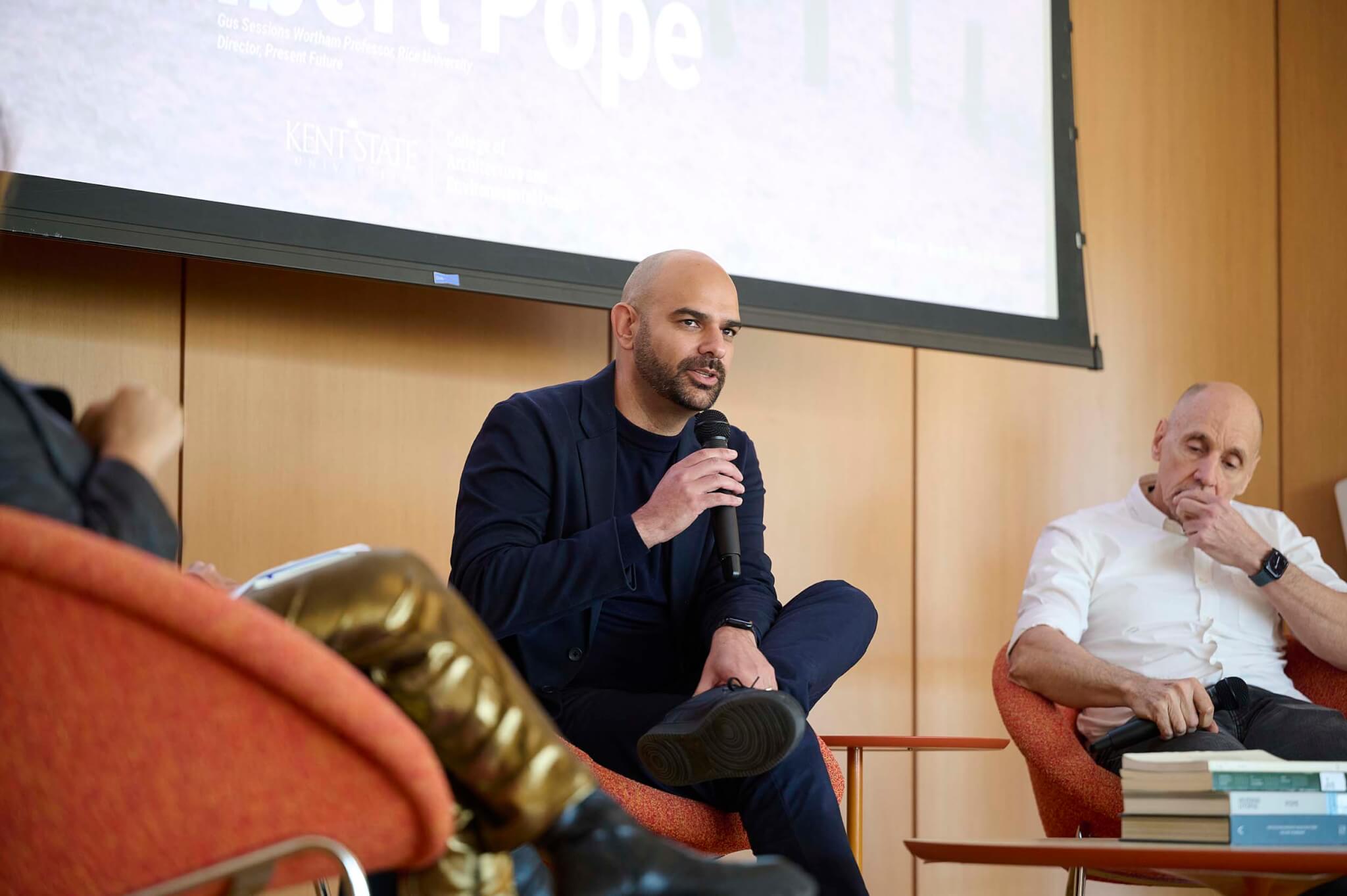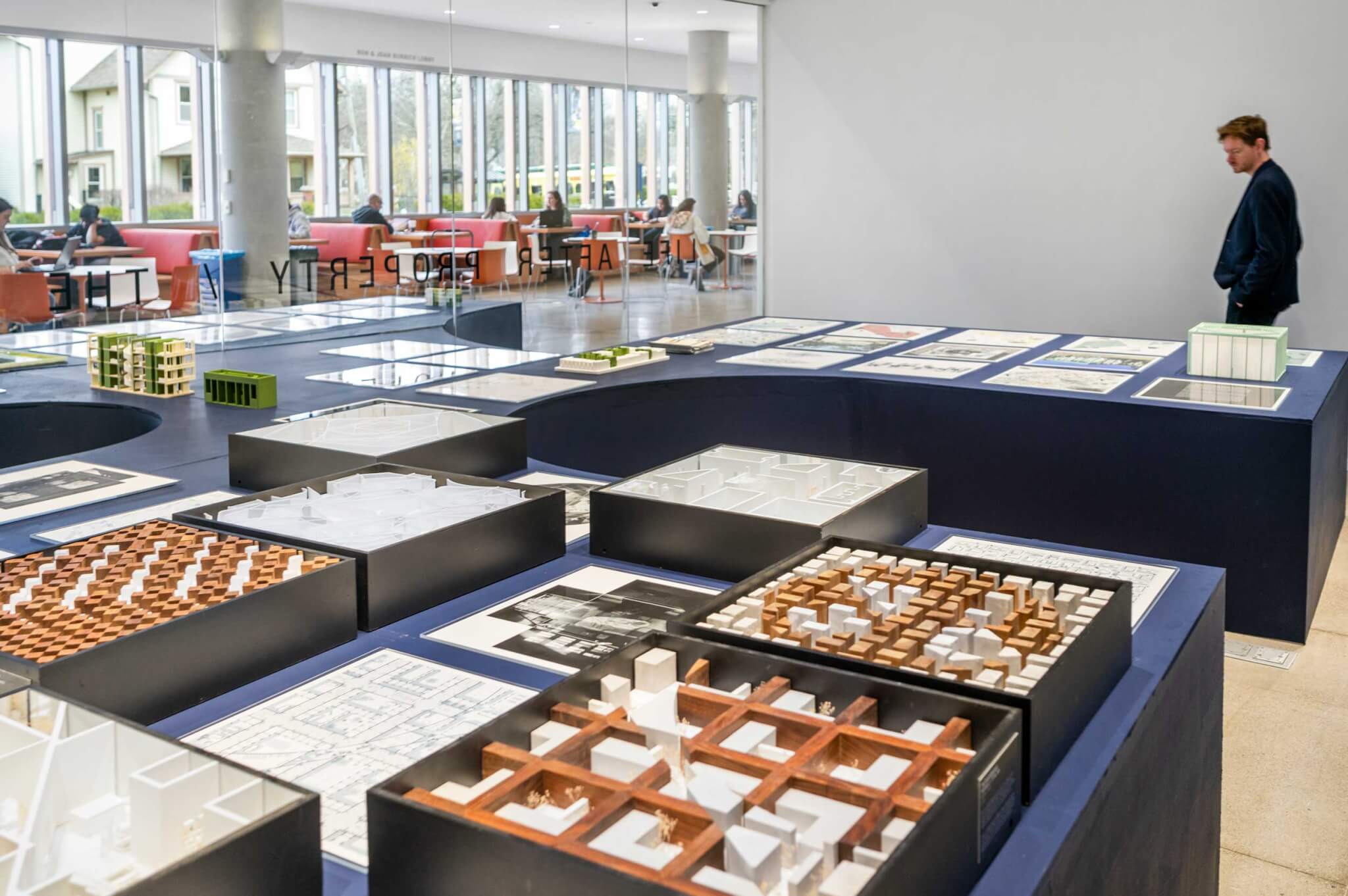A small home in Wayne County, Missouri was torn apart by a tornado.
An aerial image by Jeff Roberson taken on March 15 depicts chunks of stick-framed walls and half-recognizable debris strewn across a patchy lawn in an eviscerated orthography of middle-American life. Elisa Iturbe, assistant professor of Architecture at Harvard’s Graduate School of Design, describes this scene as “an image of climate impact, climate victimhood…these walls are doing the hard work of containment, of containing the rituals of human lifestyle.”
Roberson’s image embodied the themes that emerged from the Projective Territories Symposium: The atomized fragility of contemporary American domesticity, the fundamental link between ways of living and modes of land tenure, and the necessary primacy of form in architecture’s response to the incoming upheaval of climate change.
Projective Territories was hosted at Kent State University’s College of Architecture and Environmental Design on April 3 and 4. Organized and led by the CAED’s assistant professor Paul Mosley, the symposium brought Iturbe, Columbia University’s associate professor Lydia Kallipoliti, California College of the Arts’ associate professor Neeraj Bhatia, and professor Albert Pope of Rice University to Kent, Ohio, to discuss the relationship between territory and architecture in the face of climate change.
“At its core, territory is land altered by human inhabitation,” read Mosley’s synopsis. “If ensuring a survivable future means rethinking realities of social organization, economy, and subsistence, then how might architecture—as a way of thinking and rethinking the world—contribute to these new realities?”
Projective Territories kicked off on the afternoon of April 3 with a discussion of Bhatia’s Life After Property exhibition hosted at the CAED’s Armstrong Gallery. The exhibition collected drawings, renderings, and models by Bhatia’s practice The Open Workshop on a puzzle-piece shaped table constructed from plywood and painted blue. Nestled into the table’s geometric subtractions, Bhatia, Pope, Mosley, and CAED associate professor Taraneh Meshkani discussed Bhatia’s research into the commons: A system of land tenure by which communities manage and share resources with minimal reliance on the state through an ethic of solidarity, mutualism, and reciprocity.

The symposium’s second day was organized into a morning session, “The Erosion of Territory,” with lectures by Kallipoliti and Iturbe, and an afternoon session, “The Architecture of Expanding Ecologies,” with lectures by Bhatia and Pope.
Mosley’s introduction to “The Erosion of Territory” situated Kallipoliti and Iturbe’s work in a discussion about “how territories have been historically shaped by extraction and control and are unraveling under strain.”
Lydia Kallipoliti’s lecture “Ecological Design; Cohabiting the World” presented questions raised by her 2024 book Histories of Ecological Design; An Unfinished Cyclopedia, which she described as “an attempt to clarify how nature as a concept was used in history.” Kallipoliti proposed an ecological model that projects outward from domestic interiors to the world to generate a “universe of fragmented worldviews and a cloud of stories.” Iturbe’s “Transgressing Immutable Lines” centered on her research into the formal potentials for Community Land Trusts—nonprofits that own buildings in trust on existing real estate. Iturbe described these trusts as “Not just a juridical mechanism, but a proposal for rewriting the relationship between land and people.”
“Ecology is the basis for a more pleasurable alternative,” said Mosley in his introduction to the day’s second session. “Cooperation and care aren’t the goals, but the means of happiness.”

Neeraj Bhatia’s lecture “Life After Property” complemented the previous days’ exhibition, problematizing the housing crisis as an ideological commitment to housing rooted in market speculation. Bhatia presented new typologies for collective living with the flexibility to formally stabilize the interpersonal relationships that define life in the commons. Albert Pope finished the day’s lectures with “Inverse Utopia,” presenting work from his 2024 book of the same name, which problematizes postwar American urban sprawl as an incapability to visualize the vast horizontal expansion of low-density development.
Collectively, the day’s speakers outlined a model that situated the American domestic form at the center of the global climate crisis. Demanding complete separation from productive territories, this formal ideology of the isolated object is in a process of active dismemberment under climate change. The speakers’ proposed solutions were unified under fresh considerations of established ideas of typology and form, directly engaging politics of the collective as an input for shaping existing space. As Friday’s session drew to a close, the single-family home appeared as a primitive relic which architecture must overcome. Albert Pope’s images of tower complexes in Hong Kong and council estates in London that house thousands appeared as visions of the future.
“The only way we can begin to address this dilemma is to begin to understand who we are in order to enlist the kinds of collective responses to this problem,” said Pope.
Walker MacMurdo is an architectural designer, critic, and adjunct professor who studies the relationship between architecture and the ground at Kent State University’s College of Architecture and Environmental Design.
→ Continue reading at The Architect's Newspaper
